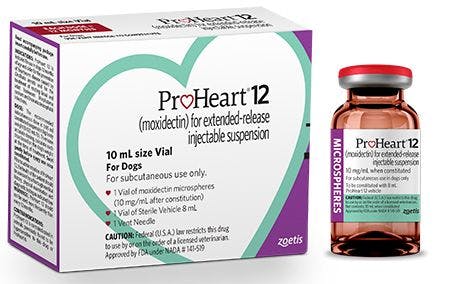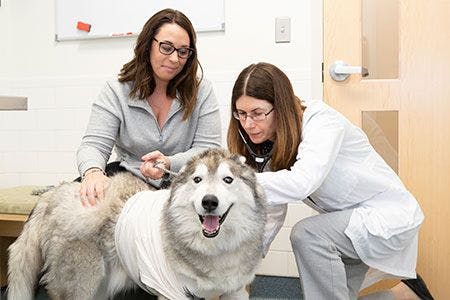Veterinary rehab recommendations: Client collaboration and pricing made easier
Veterinary specialists David Dycus, DVM, MS, CCRP, DACVS-SA, and Matthew Brunke, DVM, DACVSMR, CCRP, CVPP, CVA, weigh in on how to motivate clients and what to charge for your services.
absolutimages/stock.adobe.com

Rehabilitation is an important part of the treatment plan for animals recovering from orthopedic or neurologic surgery and soft tissue injury, as well as those with osteoarthritis, neurologic conditions and obesity. But how do you engage pet owners to ensure they comply with your recommendations for professional rehab and follow through with your instructions for at-home exercise?
The keys, say David Dycus, DVM, MS, CCRP, DACVS-SA, and Matthew Brunke, DVM, DACVSMR, CCRP, CVPP, CVA, who are on staff together at Veterinary Orthopedic & Sports Medicine Group in Annapolis Junction, Maryland, are to outline the benefits of rehabilitation and set goals that make the task fun.
Getting started
“It is often best to explain the advantages of rehab for pets in terms of human medicine,” Dr. Dycus told dvm360. Pets are like us in this regard, he says. If we have an orthopedic problem, our doctor will diagnose the condition, begin pharmaceutical intervention if needed and perform surgery if indicated.
For many nonsurgical orthopedic problems-and for just about every orthopedic surgical procedure-we'll be sent to a physical therapist to work on improving pain, regaining and maintaining strength and range of motion, and improving coordination. Likewise, pet owners need to understand that veterinary rehabilitation helps to manage pain, promote mobility and return patients to the most functional state possible.
Formal rehab therapy occurs once or twice a week and includes such professional modalities as laser therapy (photobiomodulation), therapeutic ultrasound, electrical stimulation, underwater treadmill workouts and therapeutic exercises. But the home exercise plan is just as important to enable progression and “graduation” from formal therapy, Dr. Brunke says.
“Owners don't want to hurt their pets and often are unsure how far to push the pet to assist with healing while avoiding injury,” he points out. “So, we need to explain the importance of formal rehabilitation therapy and then show owners how to exercise the pet at home.”
Some owners can be taught to perform manual therapies at home, including light massage, pulsed electromagnetic field therapy, passive range of motion and light stretching, but much of the home care program involves controlled leash walks.
“The idea is to restrict activity but allow for regular controlled movement with active muscle engagement,” Dr. Dycus says. “We aim to have dogs walk 30 minutes two or three times a day, seven days a week,” Dr. Brunke adds.
Stress the importance of warming up the pet before exercising. “Taking a dog right out of the crate or car for a 5-mile run isn't recommended,” Dr. Brunke says. Prepare by mimicking the activity to be performed for 5 to 10 minutes at one-quarter or one-half the speed that it will be done during exercise.
Setting goals
Communication is key in rehab. “Be honest with clients, provide important information in multiple ways and set reasonable goals,” Dr. Brunke advises. “Tailor the program to each client and patient by asking clients what they like to do with their pet and what they want to get back to doing. From there, you can plan how to achieve those goals.”
Explain that rehab and tissue healing take time. “Depending on the nature of the injury and how the body is healing and responding to therapy, it may be two or three months before the pet is able to return to normal daily activities,” Dr. Dycus says.
To ensure that owners follow through with the home care regimen, make it fun for them by setting goals. Here are some ideas:
- Take before and after photos so owners can see the effect of their hard work. Suggest that your clients reward themselves and their pet when they achieve certain goals.
- Track your walks with a phone app (e.g. MapMyWalk).
- Teach your dog new tricks (e.g. sit to stand, walking backward, give a paw), and build on them.
- If the pet is able, discuss how the owner can make the dog part of a running program.
- Get involved in a dog-friendly sport such as lure coursing or agility.
- Ask owners to post fun activities on social media and tag your hospital in them.
- Have them “check in” for rehab on social media at your practice.
Pricing your services
Money is often a client concern, so be practical about what professional rehab services (and with what frequency) your practice can provide versus what the owner can do at home. The best outcomes typically occur when both sides work together. “If the pet can't come as often as we like, we'll move on to a ‘plan B' that still meets most of the goals, but it may take longer,” Dr. Brunke says.
Rehabilitation consults typically take longer than an annual physical exam, so charge more for them, Drs. Brunke and Dycus advise. Also, they emphasize, charge for rechecks! “We set up reasonable rechecks and reassess to determine whether we have met our goals or need to continue with the same plan or move to a conditioning program,” Dr. Dycus says.
Rehab visits can range from 30 to 90 minutes in length. The per-visit cost will vary depending on geographic location and whether the practice is a specialty or general hospital.
Rehab visits are typically a technician-driven service, but when deciding what to charge, you have to factor in the hourly wage of the technician, the technician's skill level and training, practice overhead and your profit.
In most cases one rehab session is not going to solve the problem. Although you can price individual rehab sessions higher, Drs. Brunke and Dycus think it's a good idea to offer a package deal, keeping in mind all of the associated costs.
Some services (such as postoperative laser therapy or a massage session) can be priced a la carte, Dr. Brunke says, but he finds it best to charge by units of time and then let the rehab professional use that time as they see fit for that patient that day. “Allowing owners to pick and choose which services they want or can afford (like at a salad bar) may handcuff our progress for the patient,” he says.
Although clients may balk at paying a package rate up front for rehabilitation services, Dr. Brunke says, this can streamline the process for everyone. The client doesn't have to check out at the front desk twice a week for six to eight weeks, and staff time is freed up to help other clients.























